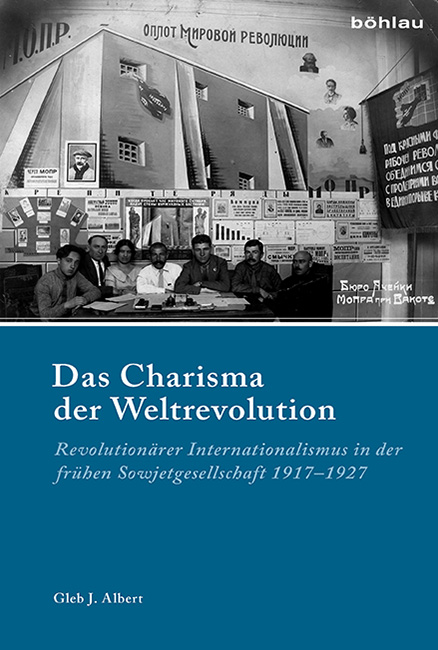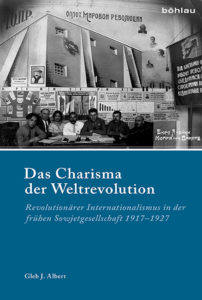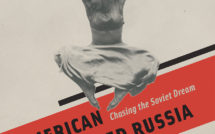
Das Charisma der Weltrevolution. Revolutionärer Internationalismus in der frühen Sowjetgesellschaft 1917-1927 by Gleb J. Albert
 This is part of our special feature, Diversity, Security, Mobility: Challenges for Eastern Europe.
This is part of our special feature, Diversity, Security, Mobility: Challenges for Eastern Europe.
This year, the centenary of what used to be called the “Great October Socialist Revolution,” has seen the publication of numerous new works on the epoch-making event, its causes, and its consequences. Among these is Gleb Albert’s impressive study of the role of “world revolution” in the Soviet state’s first decade. Based on profound research in a number of archives, as well as a thorough reading of contemporary periodical, memoir, and propaganda literature, this study makes a significant contribution to our understanding of communist self-perception and world view in the crucial first decade before Stalinism established absolute control. Anyone interested in the Russian Revolution, or in world history of the twentieth century should read this book.
The naïve reader’s initial reaction to the book’s title may be that Albert is knocking at an open door: who, after all, would deny that “revolutionary internationalism” and the dream of the world revolution were key elements in the early Soviet worldview? After all, Leon Trotsky’s “permanent revolution” was in essence simply a re-stating of that fundamental Marxist perception that “the” revolution could not occur only in a single country – and certainly not in a relatively backward country like Russia – but would provide the spark for a revolutionary world conflagration. Any survey of Russian history in the twentieth Century will offer the old chestnut of Lenin’s expectation in late 1917 that revolution would soon spread to Germany (in particular) and then throughout the world. While this initial attitude is generally admitted in the historiography, however, many historians assume that after the failure of Central European revolutions (1918-1919), the Soviet communists turned increasingly inward, and “world revolution” was mainly downplayed or offered mere lip service. Albert argues against this view and offers a great deal of documentary evidence that even during the NEP period (starting in 1921), communists and the USSR as a political power were vitally engaged and informed by the “charisma of world revolution.”
Albert makes his forceful argument by approaching the issue from several sides: chronologically, ideologically, in the forms of domestic agitation and attempts at international propaganda and expressions of solidarity, for example, with the British General Strike in 1926, and with representatives of radical German workers throughout this period. In particular, the heroes of Albert’s story are less the central party officials than enthusiasts, both in the center and throughout the USSR.
The book begins with a long chapter (well over 100 pages) covering the entire decade after the revolution from the prism of “world revolution” and Soviet society. Here, Albert begins with a fairly traditional (for specialists, anyway) discussion of Bolshevik internationalism during the World War and revolution. As said, historians seldom deny the importance of world revolution as a communist ideal in this early period. From 1918 onward, however, things get more interesting. Albert sets up his argument by looking in depth at three “snapshots” in time: 1918/19, 1923, and 1926. The first period was one of considerable chaos, revolution in Kiel, Berlin, Munich, and Budapest, and hopes that indeed world revolution was taking place already. By 1923, after the official creation of the USSR and inauguration of the New Economic Policy – generally regarded as a step back from radical communist policies of the previous years – it appeared the world revolution had receded significantly from the communist mentality. Not so, argues Albert, while admitting that Soviet communists recognized that world revolution might tarry somewhat, they continued to push for it – in 1923, in a fairly disastrous way by encouraging revolutionary action in Germany during the Ruhr/inflation crisis. In 1926, the third “time window” Albert selects, the communist activists actively supported and expressed sympathy for the General Strike in the UK, leading to strained relations with that country and in 1927 (for reasons not specifically connected to this support for the General Strike) to a break in relations. Admittedly, the Soviet commitment to world revolution did not bear immediate fruit (one misses here any specific analysis of attitudes toward the Chinese Communist party, possibly because of Eurocentrism on the part of Soviet activists), but Albert does demonstrate considerably interest in the topic, including the collection of millions of rubles of donations to support revolution abroad.
The rest of the book examines, at some considerable length and depth, various aspects of activist activities in supporting, propagandizing, and fomenting world revolution. For Albert, the key factor is not the actual effect these efforts had on spreading world revolution, but rather what these activities and organizations, the press coverage of world revolution, and the language used by activists can tell us about the mentality of early Soviet society. He demonstrates, for example, that even during the NEP – a period traditionally seen as a “retreat” from activist enthusiasm – world revolution had lost none of its charm for many communists. In speeches, “agitprop,” meetings with foreign leftists, and press organs in the provinces, world revolution remained a vital and constantly re-visited topic.
The continued interest in world revolution was embodied in institutional form in MOPR – the International Organization for the Help of Fighters of the Revolution. This mass organization that boasted up to 10 million members was the Soviet branch of the Comintern’s “International Red Help.” Albert argues that in the 1920s, MOPR was often surprisingly independent in its policies and expressions of international solidarity with leftist political prisoners. Not just in the Russian republic of the USSR, but also in the Ukrainian republic, in the Caucasus, and even Central Asia, tens and even hundreds of thousands of MOPR members were signed up in the mid-1925s. To be sure, we can guess that many of these were more pro forma than enthusiastic members but Albert argues that we should not exaggerate the level of cynicism at this point. Rather, the fact that millions of Soviet citizens joined this organization for international revolutionary solidarity attests to the high level of interest felt within the young USSR for the spread of revolution.
Albert documents a number of practices that show this enthusiasm, among them, collecting donations for various foreign causes (often strikers or political prisoners), exchange of gifts with foreign leftists (e.g., a bust of Lenin in soap from a Viatka soap factory), and most curiously, the exchange of banners between factories and organizations from within the USSR with leftists groupings in foreign lands. Albert also discusses – all too briefly! – the importance of Esperanto in this context. However, for a fuller treatment of Esperanto in the USSR we will have to await the upcoming work of Brigid O’Keeffe.
To conclude, Gleb J. Albert has produced an admirable work of scholarship on the first decade of Soviet society. The lens of “world revolution” not only gives us insight into Soviet foreign policy but even more, it helps us to understand the nature of communist enthusiasm during these years. Drawing on a number of archives in Russia and abroad, informed by a great deal of reading in contemporary periodicals and propaganda works, this study does much to help us understand just how early Soviet activists saw their world and their place in it. Das Charisma der Revolution is a worthy addition to the literature on the Russian Revolution in this centenary year.
Reviewed by Theodore R. Weeks, Southern Illinois University, Carbondale
Das Charisma der Weltrevolution. Revolutionärer Internationalismus in der frühen Sowjetgesellschaft 1917-1927
by Gleb J. Albert
Publisher: Cologne-Weimar-Vienna: Böhlau
Hardcover / 631 pages / 2017
ISBN: 9-783412-507541
To read more book reviews, please click here.
Published on December 6, 2017.




